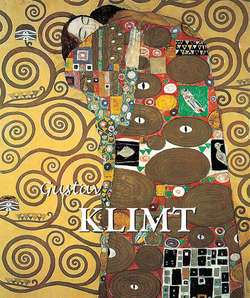Читать книгу Gustav Klimt - Patrick Bade - Страница 8
На сайте Литреса книга снята с продажи.
His Life
Lovers and Friends
ОглавлениеOne of the most tantalising facts about a man so well-known in times comparatively recent to our own is that almost nothing concrete is known about Klimt’s personal life, a fact largely due to his own reticence on the subject. Whilst the facts of his artistic career are well-charted, knowledge of his private life depends entirely on hearsay.
Jurisprudence, 1907.
Oil on canvas, 430 × 300 cm.
Burnt in 1945 at Immendorf Castle.
Music, 1901.
Lithograph.
Marie Moll, 1902–1903.
Pencil, 45.2 × 31.4 cm.
Kunsthistorisches Museum, Vienna.
Fairy Tale, 1884.
Black pencil and ink wash, 63.9 × 34.3 cm.
Kunsthistorisches Museum, Vienna.
Final Drawing for the Allegory of Sculpture, 1902–1903.
Black pencil, graphite pencil lead, wash and gold, 41.8 × 32.3 cm.
Historisches Museum, Vienna.
Flowing Water, 1898.
Oil on canvas, 52 × 65 cm.
Private collection.
Death’s Procession, 1903.
Burnt in 1945 at Immendorf Castle.
On the one hand, he is depicted as a ladies’ man, built like a peasant, strong as an ox, sleeping with countless women, including all of his models. On the other hand, he is seen as a hypochondriac and a confirmed bachelor with a balanced lifestyle, living with his mother and sisters while keeping a studio in the suburbs to which he went to work regularly every day:
Klimt’s daily routines were very bourgeois. He was so engrossed in them that any divergence from his normal course was a horror to him; going anywhere was a major event, and a big trip was only conceivable if his friends did all the shopping for him beforehand, down to the smallest detail.
(Hans Tietze, Gustav Klimts Persönlichkeit nach Mitteilungen seiner Freunde [Gustav Klimt’s Personality According to Messages from His Friends], 1919).
Klimt never married, but had a long relationship with Emilie Flöge, the sister of his brother Ernst’s wife. In 1891, Ernst had married Helene Flöge, one of two sisters who ran a fashion house in Vienna. The marriage only lasted fifteen months, but through Helene, Gustav met Emilie. From around 1897 onwards, he spent almost every summer on the Attersee with the Flöge family, periods of peace and tranquillity, which produced the landscape paintings constituting almost a quarter of his entire œuvre.
The exact nature of Klimt’s relationship with Emilie Flöge remains unknown. They never lived together, and although it was Emilie whom Klimt requested on his death bed, there has always been a great deal of speculation as to whether they were actually lovers.
Roses in Trees, 1904.
Oil on canvas, 110 × 110 cm.
Musée d’Orsay, Paris.
Pear Tree, 1903.
Oil and casein on canvas, 101 × 101 cm.
Harvard University Art Museums, Cambridge, Massachusetts.
Klimt corresponded extensively both with Emilie and with Marie (Mizzi) Zimmerman, who was the mother of two of his three illegitimate children. He writes to Marie with great affection and in detail about his work and daily life, whilst to Emilie he appears to write merely in order to communicate information concerning travel arrangements and other such neutral details.
But who is to tell where the truth ultimately lies? It is perfectly possible that more personal correspondence between Klimt and Emilie did exist, but was subsequently destroyed.
His 1902 portrait of Emilie shows an attractive young woman wearing one of her own dresses, many of which Klimt designed for her fashion house, as well as jewellery and textiles. It’s a remarkably subdued painting, with just a subtle, tantalising hint of sensuality in the light patch of skin just above the bodice, suggesting the hidden breast beneath. How different from the 1903 painting Hope I, which depicts a naked and heavily pregnant woman, Herma, one of Klimt’s favourite models.
The story goes that one day Herma, whom Klimt apparently described as having a backside more beautiful and more intelligent than the faces of many other models, failed to turn up for work. Klimt, who took very good care of his models, began to worry and finally sent someone to find out if she was ill. Upon hearing that she was not ill but pregnant, Klimt insisted that she came to work anyway. She then became the model for Hope I.
This fragile, slender woman looking calmly out at the viewer is anything but maternal. Her figure, apart from her distended stomach, is still that of a young woman, thin to the point of skinniness. Her hair is crowned with flowers as if she were a bride. Depending on one’s point of view, her direct gaze and unashamed nakedness shown in profile for maximum effect, are either pointing out the obvious consequences of sex, or inviting a still-sexual response to her body.
The later Hope II, painted in 1907–1908, has a far more maternal feel. The woman’s breasts are full and large-nippled, her head bowed in a peaceful, almost Madonna-like pose. She is enclosed by a fabric that follows an abruptly straight line down her back as if she were actually sitting on a straight-backed chair being carried by the figures underneath her. The last great hope of humankind, transported on the backs of other women.
When Klimt died, there were no fewer than fourteen claims that he was the father of an illegitimate child, only three of which were legally upheld – two by Marie Zimmerman and one by Maria Ucicky. (The child was named Gustav after his father and later went on to become a film director). It is generally assumed that he slept with most of his models.
He was certainly known to be very generous towards them. Who knows whether the pregnancies depicted in his paintings had any connection with the painter himself? If they did, Herma’s gaze in Hope I takes on an entirely new meaning: a look of reproach? Or one of irony?
